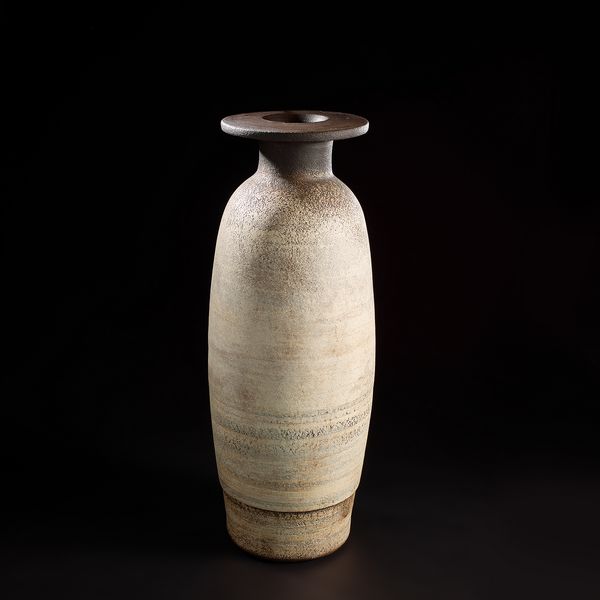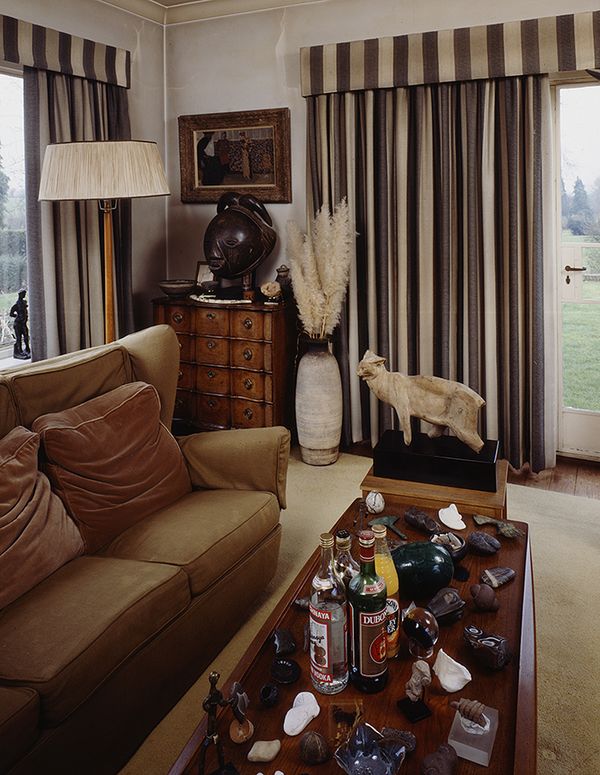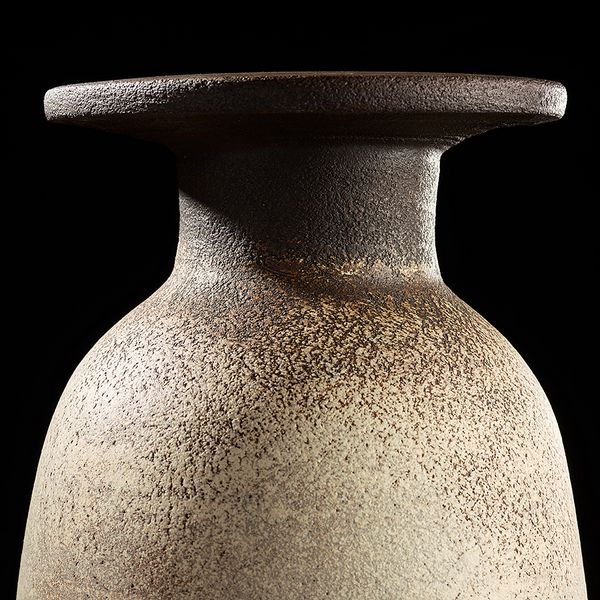Henry Moore in his sitting room, Christmas Day 1970. Photo: Errol Jackson. Courtesy Henry Moore Archive.
Hans Coper’s monumental bottle looked particularly at home in Henry Moore’s sitting room at Hoglands. After all Coper and Moore shared a Modernist language that derived much from their mutual admiration for some of the earliest sculpture, from Neolithic objects to Cycladic figures and pots, from Minoan Cretan jugs to Ancient Egyptian statues and the tribal art of sub-Saharan Africa. What both artists showed was a remarkable ability to distil time-honored forms into an abstracted expressiveness of their own, and to refine and develop their ideas, about materiality and evolving shapes, over years and decades. Whether we are looking at Moore’s evolution, say, of the reclining figure or Coper’s obsession with the physical and metaphorical significance of the standing vessel, specifically here the bottle, what was clear was that both potter and sculptor were first and foremost students of the museums (notably the British Museum), where both learned so much about the expressive power of the archaic and the archetypal.

Hans Coper, Monumental bottle with disc top, ca. 1959. Design London.
Harry Fischer (1903–1977), the inimitable co-founder of Moore’s agents, Marlborough Fine Art, knew how much Moore admired Coper’s work, and he commissioned this bottle as a Christmas present for the sculptor. It was one of the earliest in a series of bottles of various size and shape which Coper continued to refine through the 1960s and into the early 1970s. As well as bottles that could, like Moore’s, stand from the floor, Coper worked on more articulated narrower variations with flatter shoulders and barrel-like cylindrical sections which he began making in the later 1950s (with taller versions produced later). Moore’s pot was part of an initial group of more curvaceous ‘milk bottle’ forms, worked on through 1958–59, generally architectural in scale, but increased here in size and more assured, less tentative, than those illustrated in Birks. It is visually very resolved with its more emphasized ‘disc’ lip, its fuller curved belly and more pronounced throwing indentation towards the base. It is clearly the most direct prototype for the large bottles with discs produced a decade on, two important examples of which, from 1972, were recently sold by Phillips.

The sitting room of Henry Moore’s home, Hoglands, with artworks and natural objects from his collection on display. Photo: Prudence Cuming Associates.
The period in which this bottle was made was particularly significant for Coper, playing as he did with a number of different structural ideas that would mature in the years ahead. At this time, he was still working in Lucie Rie’s studio at Albion Mews, experimenting too with various cylindrical waisted forms, some of which were exhibited at Henry Rothschild’s gallery Primavera in May 1958, Coper's first one-person show in England. That exhibition also included an abstractly decorated sgraffito manganese jar from 1952, offered in this sale, and of fine and unusual globular type. Work for the Primavera show had threatened to overcrowd Rie’s studio, and precipitated Coper’s move to more spacious facilities at the newly founded arts community at Digswell, in Hertfordshire, in early 1959.
This very significant piece unites two masters of their mediums, both of whom understood sculptural essence, and just how humanely a made object can extend our sensory experience.
Coper was naturally very aware of the experimental ferment in 1950s British art, a time of anxiety with all the damage, uncertainty and alienation of the post-war landscape, and which artists reacted to with sculpture described in 1952 by the critic Herbert Read as the “iconography of despair, of defiance … the geometry of fear.” Henry Moore responded in his own way with the powerful helmet and warrior pieces of that decade, and sculptors like Eduardo Paolozzi, Kenneth Armitage, and William Turnbull also produced work with a pronounced totemic quality, art that was figurative or alluded to the figure. But if Coper’s references were more oblique, he was clearly as indebted to the upright human form, and the sentinel, often anthropomorphic presence of his pots was just as haunting, particularly when seen in the atmospheric studio groups photographed by his wife, Jane Gate. He greatly admired these qualities (as well as the hieratic, almost timeless aspects) in the work of Brâncuși and Giacometti, whose sculpture was a considerable influence on the potter. And it can be argued that if Moore was essentially, in his great reclining figures, the exponent of resting horizontality, so Coper’s preoccupation was with a more taut verticality, each artist deeply indebted to archetypes from early history.

Hans Coper, Monumental bottle with disc top (detail), ca. 1959. Design London.
Both Moore and Coper embraced modern architecture, working with it in many of their public commissions. Coper’s sculptural approach and acute sense of color and scale was ideal for buildings, best exemplified in the major commission to design the Coventry Cathedral candlesticks in 1962. These six tall monolithic structures, thrown in giant sections, were direct descendants of Moore’s bottle and the narrower ‘barrel’ versions started earlier in this period. They were closely connected in shape and conception, the candlesticks narrowing to the kind of more pronounced disc first seen on Moore’s bottle, but here deepened to form a cup for each candle. Like the bottle, the glazes and slips added texture and character to the coarse face of the clay, an almost stone-like effect which emphasized a sense, not of decoration, but of bold sculptural mass, demonstrating Coper’s skill in making work as an integral part of a larger structure. The vessel owned and very much used by Henry Moore (notice the bulrushes in the photograph) exemplified Coper’s ability to produce ceramics for a more intimate modern space and environment too, and here, like the candlesticks, there is that architectural quality of ritual, enduring in its apparent simplicity. This very significant piece unites two masters of their mediums, both of whom understood sculptural essence, and just how humanely a made object can extend our sensory experience.
Discover More from Design London >
Recommended Reading
